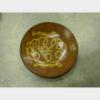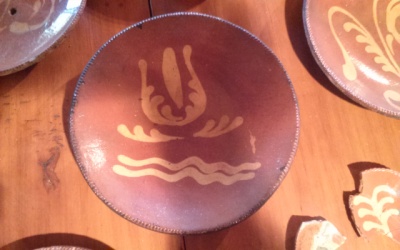Pie plates were a common everyday item used in the kitchen for centuries in Europe. In Colonial Pennsylania, potters were influenced by traditional German sgraffito plates. Sgraffito is a technique in which the body of a pot is covered with slip of a different color clay. The coating is carved away exposing the under body color of the pot. Slipware usually occurs as an earthenware core that has been decorated with slip or liquid clay. Slipware was introduced to this country by the Netherlands in the late sixteenth and early seventeenth centuries. Soon after the English Staffordshire tradition was born. Slipware began to be made in Sussex, Kent Somerset and Devon Counties. The wares produced in these English counties also influenced the local American potteries that produced earthenware pie plates. I am guessing that local earthenware pie plate production started soon after Colonial settlement in Philadelphia. These wares were not difficult to make and were essential to everyday life. Raw materials such as clay and wood, for firing, were abundant in the surrounding area. Whole Colonial examples of slipware or sgraffito pie plates are very rare. The earliest example I have seen at the Philadelphia Museum of Art is from 1792. There is an entire reference book documenting the Museum's extensive collection. Most of the plates seen in this photo album are c1840-60. Most are dug from privies in Philadelphia and restored. In about 1860 the popularity of earthenware decorated vessels and plates plummeted. People began to favor the cleaner looking yellow ware pottery made famous by the Bennington, NH potteries. The Bennington style pottery was fired to a higher temperature and resisted under glaze staining much better that the lower fired earthenware red pie plates.
Redware Plate With Tulip Decoration
This group of 3 redware plates was found while investigating a crawl space of an early farm house on Hamilton Boulevard in South Plainfield, NJ about 1985 by Joe Butewicz, Kent Theurich and Joe Guth. I discovered and opened the small part, of long sealed off crawl space below, the old kitchen. The remainder of the basement was fully dug out and there were 4 or 5 bushel baskets there, full of early broken ceramic dishes mostly pearl ware, mocha ware, transfer ware, gaudy Dutch, other hand painted ware and porcelain export china.Each plate was found in about 3 or 4 pieces and two were missing quarter size triangles. Kent sold his plate to Joe within a year or two of the discovery and Joe had both plates repaired by Jim Evans of Haddonfield, NJ. I traded my plate to Joe about 5 years after the find for a very nice cobalt decorated, squatty, salt glazed jug. I Also had Jim restore my plate before I trade it away.
Comments (0) | Add a Comment








